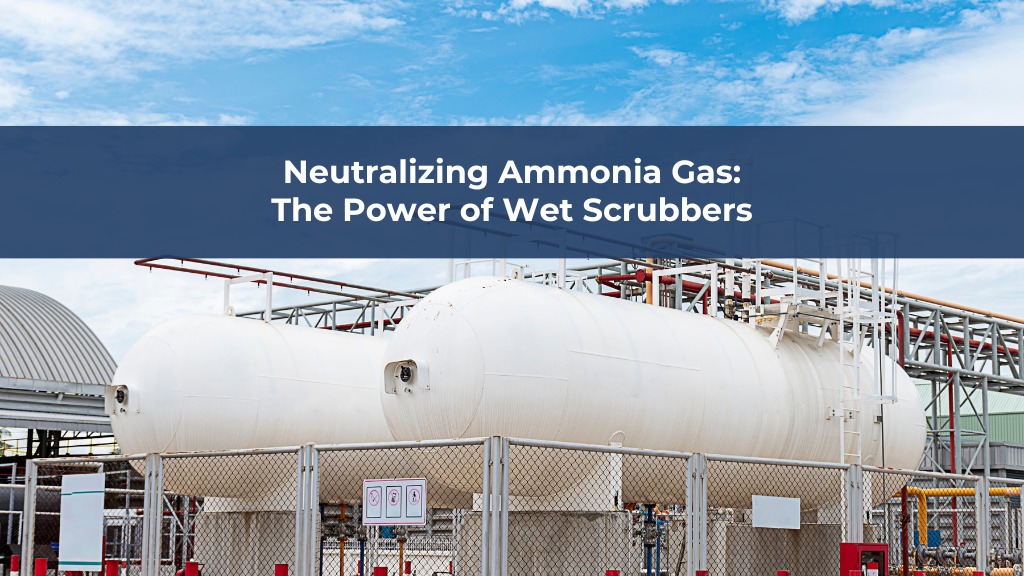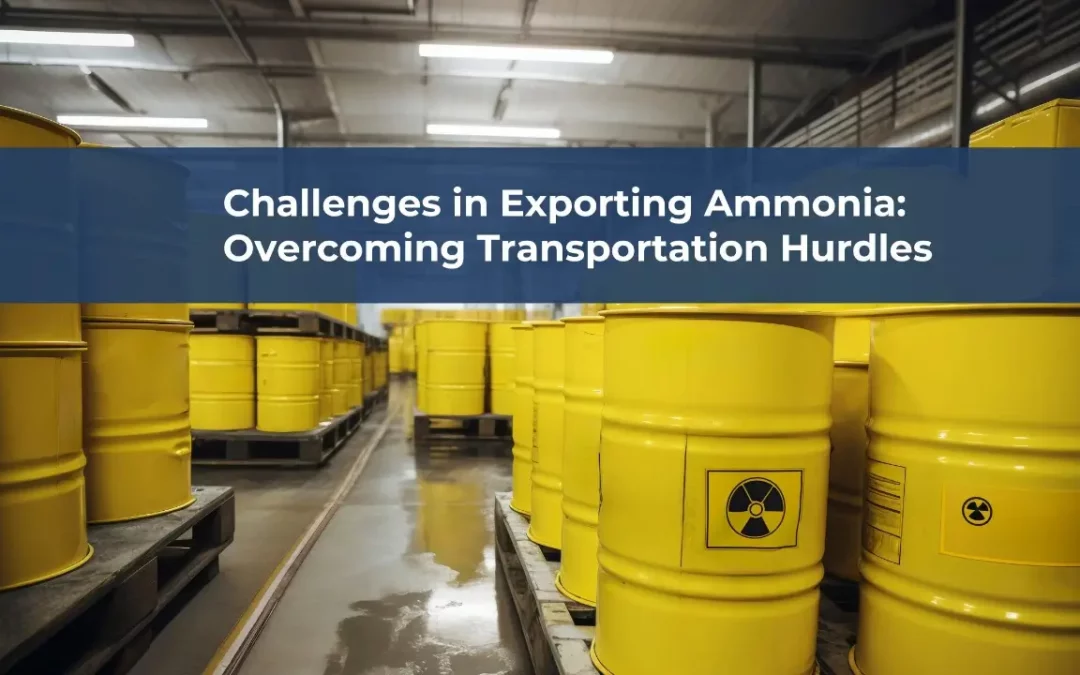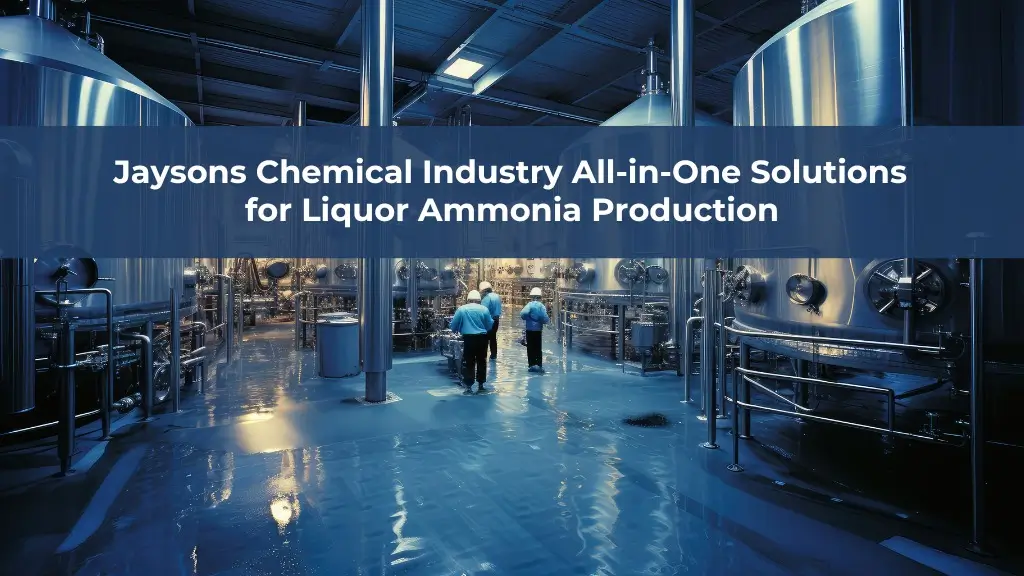Ammonia gas may not be a topic that comes up in everyday conversation, but its impact on our health and the environment cannot be ignored. Understanding the chemical properties of ammonia gas and the risks it poses is crucial in finding effective solutions to neutralize it. Thankfully, wet scrubbers have emerged as a powerful tool in combating this hazardous gas.
Understanding Ammonia Gas and Its Impact
Ammonia gas, chemically known as NH3, is a colorless gas with a pungent odor that can be found in various industrial processes and natural habitats. It is commonly used in fertilizers, refrigerants, and cleaning products. While ammonia has its uses, it also comes with health and environmental risks that cannot be ignored.
The Chemical Properties of Ammonia Gas
Ammonia gas is highly soluble in water, which means it can easily dissolve and mix with moisture in the air or in our respiratory systems. This poses a significant risk, as exposure to high levels of ammonia gas can cause irritation to the eyes, nose, throat, and lungs. Prolonged or severe exposure may even lead to respiratory issues and long-term health problems.
Health and Environmental Risks of Ammonia Gas
Aside from its impact on human health, ammonia gas also contributes to environmental concerns. When released into the atmosphere, ammonia can react with other pollutants and contribute to the formation of fine particulate matter and ground-level ozone. These pollutants can have detrimental effects on air quality and pose serious risks to ecosystems and wildlife.
Furthermore, ammonia gas can have a significant impact on aquatic ecosystems. When ammonia is released into bodies of water, it can lead to an increase in nutrient levels, particularly nitrogen. This excess nitrogen can cause eutrophication, a process where excessive nutrients stimulate the growth of algae and other aquatic plants. As a result, oxygen levels in the water can decrease, leading to the death of fish and other aquatic organisms.
In addition to its impact on aquatic ecosystems, ammonia gas can also contribute to soil pollution. When ammonia-based fertilizers are used in agricultural practices, excess ammonia can be released into the soil. This can lead to soil acidification, which negatively affects soil health and the growth of crops. Furthermore, ammonia can also leach into groundwater, potentially contaminating drinking water sources and posing a risk to human health.
The Science Behind Wet Scrubbers
Now that we have a better understanding of the dangers posed by ammonia gas, it’s time to explore the science behind wet scrubbers and how they can effectively neutralize this harmful substance.
The Basic Principle of Wet Scrubbing
Wet scrubbers work on the principle of absorption, using a liquid solution to capture and neutralize pollutants such as ammonia gas. The process involves passing the contaminated gas through a scrubber tower or chamber, where water or a chemical solution is sprayed or trickled down. This creates a scrubbing action, allowing the solution to come into direct contact with the gas and remove the pollutants.
But how exactly does this scrubbing action work? When the contaminated gas enters the scrubber tower, it encounters a high-velocity stream of liquid droplets. These droplets collide with the gas molecules, causing them to dissolve or react with the liquid. This physical and chemical interaction between the gas and the liquid effectively removes the pollutants, leaving behind clean air.
Different Types of Wet Scrubbers
There are various types of wet scrubbers available, each designed to suit specific industrial needs and requirements. Some common examples include packed bed scrubbers, spray tower scrubbers, and venturi scrubbers. Each type employs unique mechanisms to ensure efficient pollutant removal and neutralization.
Let’s take a closer look at packed bed scrubbers. These scrubbers consist of a tower filled with a packing material, such as plastic or ceramic, which provides a large surface area for the gas and liquid to come into contact. As the gas passes through the tower, it comes into contact with the liquid, allowing the pollutants to be absorbed or chemically reacted. The packed bed scrubbers are highly efficient in removing pollutants and are commonly used in industries where high removal efficiencies are required.
Another type of wet scrubber is the spray tower scrubber. In this design, the contaminated gas enters the scrubber tower, where it is sprayed with a liquid solution from nozzles located at the top. The liquid droplets capture the pollutants as they fall through the tower, effectively removing them from the gas stream. Spray tower scrubbers are widely used in industries where a large volume of gas needs to be treated, as they can handle high gas flow rates.
Lastly, we have the venturi scrubbers. These scrubbers use a venturi throat, which creates a high-velocity gas stream. As the gas passes through the throat, it creates a low-pressure region that draws in the liquid solution. The gas and liquid mix in the throat, allowing the pollutants to be absorbed or chemically reacted. Venturi scrubbers are known for their high collection efficiencies and are often used in applications where fine particulate matter needs to be removed from the gas stream.
The Process of Neutralizing Ammonia Gas
Now that we know how wet scrubbers work, let’s delve into the specific role they play in neutralizing ammonia gas and the key steps involved in the process.
The Role of Wet Scrubbers in Neutralization
Wet scrubbers are incredibly effective in neutralizing ammonia gas because they facilitate the direct contact between the gas and the scrubbing solution. As the contaminated gas makes its way through the scrubber, the ammonia molecules are absorbed and chemically reacted with the solution, rendering them harmless.
Key Steps in the Neutralization Process
Neutralizing ammonia gas involves a series of steps to ensure a thorough removal of the pollutant. Firstly, the contaminated gas enters the scrubber tower, where it comes into contact with the scrubbing solution. The solution reacts with the ammonia gas, forming a neutralized byproduct. Lastly, the neutralized gas is released into the atmosphere, significantly reducing the potential health and environmental risks associated with ammonia gas.
Let’s take a closer look at the chemical reactions that occur during the neutralization process. When ammonia gas comes into contact with the scrubbing solution, it reacts with water to form ammonium hydroxide, a weak base. This reaction is known as hydration, where water molecules break the ammonia’s hydrogen bonds, resulting in the formation of ammonium ions (NH4+) and hydroxide ions (OH-). These ions then combine to form ammonium hydroxide, which is highly soluble in water.
Ammonium hydroxide is an effective neutralizing agent because it can react with acidic compounds, such as sulfur dioxide or hydrogen chloride, to form less harmful substances. This reaction, known as neutralization, involves the transfer of protons from the acid to the base, resulting in the formation of water and a salt. The salt formed depends on the specific acid used, but it is generally less harmful than the original acid or ammonia gas.
It is important to note that the efficiency of the neutralization process depends on various factors, including the concentration of ammonia gas, the contact time between the gas and the scrubbing solution, and the pH of the solution. Optimal conditions must be maintained to ensure the complete removal of ammonia gas and the production of a safe byproduct.
Evaluating the Efficiency of Wet Scrubbers
Measuring the efficiency of wet scrubbers is vital in determining their effectiveness in neutralizing ammonia gas. Several factors can influence scrubber performance and overall success in reducing the harmful effects of ammonia gas.
When evaluating the efficiency of wet scrubbers, it is essential to consider not only their ability to remove ammonia gas, but also their impact on other pollutants. Wet scrubbers have the potential to remove various contaminants from industrial emissions, such as sulfur dioxide, particulate matter, and volatile organic compounds. By evaluating the overall pollutant removal efficiency, we can gain a comprehensive understanding of the scrubber’s effectiveness in improving air quality.
Factors Influencing Scrubber Performance
The efficiency of wet scrubbers can be influenced by various factors, including gas velocity, liquid-to-gas ratio, spray nozzle design, and scrubber size. It is crucial to optimize these factors to achieve the best results and ensure effective gas neutralization.
Gas velocity plays a significant role in scrubber performance. Higher gas velocities can enhance the contact between the gas and liquid phases, resulting in improved mass transfer and pollutant removal efficiency. However, excessively high gas velocities can lead to increased pressure drops and potential operational issues. Therefore, finding the optimal gas velocity is a delicate balance that requires careful consideration.
The liquid-to-gas ratio is another critical factor that affects scrubber efficiency. A higher liquid-to-gas ratio provides more contact time between the gas and liquid, allowing for better absorption of pollutants. However, an excessive liquid-to-gas ratio can lead to increased water consumption and potential wastewater treatment challenges. Therefore, finding the right balance is essential to maximize scrubber performance while minimizing water usage.
The design of spray nozzles also plays a crucial role in scrubber efficiency. The spray pattern, droplet size, and distribution uniformity can significantly impact the contact between the gas and liquid phases. Optimizing the spray nozzle design can enhance gas-liquid interaction and improve pollutant removal efficiency.
Scrubber size is another factor that should be carefully considered. The size of the scrubber determines the available contact area between the gas and liquid phases. A larger scrubber provides more surface area for gas-liquid interaction, resulting in improved pollutant removal efficiency. However, larger scrubbers may require more space and can be costlier to install and operate. Therefore, finding the optimal scrubber size is crucial to balance performance and cost-effectiveness.
Measuring the Success of Ammonia Gas Neutralization
After implementing wet scrubbers for ammonia gas neutralization, it is important to assess their impact and success. This can be done by monitoring air quality, measuring ammonia gas levels, and evaluating the reduction in health and environmental risks associated with ammonia gas exposure.
Air quality monitoring involves measuring various parameters, such as particulate matter, nitrogen oxides, and sulfur dioxide levels. By comparing the air quality before and after scrubber installation, we can determine the effectiveness of ammonia gas neutralization and the overall improvement in air quality.
Measuring ammonia gas levels is another crucial aspect of evaluating scrubber performance. Continuous monitoring of ammonia gas concentrations can provide valuable insights into the efficiency of the scrubber system. By analyzing the data, we can identify any fluctuations or trends in ammonia gas levels and make necessary adjustments to optimize scrubber performance.
Furthermore, evaluating the reduction in health and environmental risks associated with ammonia gas exposure is essential. Ammonia gas can have detrimental effects on human health, causing respiratory problems and eye irritation. It can also contribute to environmental issues, such as eutrophication and acidification. By assessing the reduction in these risks, we can determine the success of ammonia gas neutralization and the overall benefits of wet scrubber implementation.
Future Developments in Wet Scrubbing Technology
As industries continue to prioritize sustainability and environmental responsibility, innovations in wet scrubbing technology are constantly emerging.
Innovations in Scrubber Design
Scientists and engineers are continuously working on improving the design and performance of wet scrubbers. This includes the development of new materials, the application of advanced modeling techniques, and the integration of smart automation systems to optimize scrubber efficiency and reduce energy consumption.
The Role of Wet Scrubbers in Sustainable Industry
Wet scrubbers play a pivotal role in achieving sustainable industry practices by effectively removing pollutants like ammonia gas. By employing wet scrubbers, industries can significantly reduce their environmental footprint, protect human health, and contribute to a cleaner and safer future.
Now armed with the knowledge of wet scrubbers and their ability to neutralize ammonia gas, it is crucial to prioritize the adoption and implementation of these systems across various industries. The power of wet scrubbers in combating ammonia gas cannot be underestimated – they are the key to a healthier, greener, and more sustainable future.













